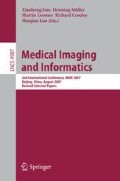Abstract
Position Emission Tomography (PET) is increasingly applied in the diagnosis and surgery in patients thanks to its ability of showing nearly all types of lesions including tumour and head injury. However, due to its natures of low resolution and different appearances as a result of different tracers, segmentation of lesions presents great challenges. In this study, a simple and robust algorithm is proposed via additive colour mixture approach. Comparison with the other two methods including Bayesian classified and geodesic active contour is also performed, demonstrating the proposed colouring approach has many advantages in terms of speed, robustness, and user intervention. This research has many medical applications including pharmaceutical trials, decision making for drug treatment or surgery and patients follow-up and shows potential to the development of content-based image databases when coming to characterise PET images using lesion features.
Access this chapter
Tax calculation will be finalised at checkout
Purchases are for personal use only
Preview
Unable to display preview. Download preview PDF.
References
Bendriem, B., Townsend, D.W. (eds.): The Theory and Practice of 3D PET. Kluwer Academic Publishers, London (1998)
Thirion, J., Calmon, G.: Measuring Lesion Grouwth from 3D Medical Images. In: IEEE Workshop on Motion of Non-Rigid and Articulated Objects (NAM 1997), pp. 112–119 (1997)
He, R., Narayana, P.A.: Detection and Delineation of Multiple Sclerosis Lesions in Gadolinium-Enhanced 3D T1-Weighted MRI Data. In: 13th IEEE Symposium on Computer-Based Medical Systems (CBMS), pp. 201–205 (2000)
Gao, X.W., Birhane, D., Clark, J.: Application of Geodesic Active Contours to the Segmentation of Lesions of PET (Positron Emission Tomography) Images. In: Gao, X., Lin, C., Müller, H. (eds.) Medical Imaging and Telemedicine, pp. 45–50 (2005)
Yin, L., Deshpande, S., Chang, J.K.: Automatic Lesion/Tumour Detection Using Intelligent Mesh-Based Active Contour. In: IEEE International Conference on Tools with Artificial Intelligence (ICTAI) (2003)
Cai, W., Feng, D.D., Fulton, R.: Content-Based Retrieval of Dynamic PET Functional Images. IEEE Trans. on Info. Tech. in Biome. 4, 152–158 (2000)
Sawle, G.V., Playford, E.D., Brooks, D.J., Quinn, N., Frackowiak, R.S.J.: Asymmetrical Pre-synaptic and Post-synaptic Changes in the Striatal Dopamine Projection in Dopa Nave Parkinsonism: Diagnostic Implications of the D2 Receptor Status. Brain 116, 853–867 (1993)
Ullmann, J.R.: Pattern Recogntion Techniques. Crane Russak, New York (1973)
Lammertsma, A.A., Brench, C.J., Hume, S.P., Osman, S., Gunn, K., Brooks, D.J., Frackowiak, R.S.: Comparison of Methods for Analysis of Clinical [1 1C]raclopride Studies. J. Cereb. Blood Flow Metab. 16, 42–52 (1996)
Liu, S., Babbs, C., Delp, E.: Multiresolution Detection of Spiculated Lesions in Digital Mammpgrams. IEEE Trans. on Image Processing 10, 874–884 (2001)
Huang, C.C., Yu, X., Bading, J., Conti, P.S.: Computer-Aided Lesion Detection with Statistical Model-Based Features in PET Images. IEEE Trans. on Nucl. Science 44, 2509–2521 (1997)
Ogata, Y., Naito, H., et al.: Novel Display Technique for Reference Images for Visibility of Temporal Change on Radiographs. Radiation Med. 24, 28–34 (2006)
Rehm, K.R.: Display of Merged Multimodality Brain Images Using Interleaved Pixels with Independent Color Scales. J. Nucl. Med. 35, 1815–1821 (1994)
Zhao, B.: Colour Space. Computer Vision Laboratory Stony Brook University, New York (2002)
Talairach, J., Tournoux, P.: Co-Planar Steriotaxic Atlas of the Human Brain. Theme Medical Publishers (1988)
Gao, X.W., Batty, S., Clark, J., Fryer, T., Blandford, A.: Extraction of Sagittal Symmetry Planes from PET Images. In: Visualization, Imaging, and Image Processing (VIIP), pp. 428–433 (2001)
Author information
Authors and Affiliations
Editor information
Rights and permissions
Copyright information
© 2008 Springer-Verlag Berlin Heidelberg
About this paper
Cite this paper
Gao, X., Clark, J. (2008). A Fast Approach to Segmentation of PET Brain Images for Extraction of Features. In: Gao, X., Müller, H., Loomes, M.J., Comley, R., Luo, S. (eds) Medical Imaging and Informatics. MIMI 2007. Lecture Notes in Computer Science, vol 4987. Springer, Berlin, Heidelberg. https://doi.org/10.1007/978-3-540-79490-5_25
Download citation
DOI: https://doi.org/10.1007/978-3-540-79490-5_25
Publisher Name: Springer, Berlin, Heidelberg
Print ISBN: 978-3-540-79489-9
Online ISBN: 978-3-540-79490-5
eBook Packages: Computer ScienceComputer Science (R0)

